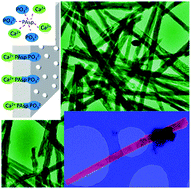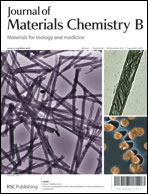The role of poly(aspartic acid) in the precipitation of calcium phosphate in confinement†
Abstract
Many questions remain regarding the formation of ultrathin hydroxapatite (HAP) crystals within the confines of collagen fibrils of bones. These structures form through the interplay of the collagen matrix and non-collagenous proteins, and in vitro mineralization studies employing poly(aspartic acid) (PAsp) as a mimic of the non-collagenous proteins have generated mineralized fibrils with structures comparable to their biogenic counterparts. In this article, we employ the nanoscale cylindrical pores perforating track-etch filtration membranes to investigate the role of PAsp in controlling the infiltration and crystallization of calcium phosphate (CaP) within confined volumes. Oriented polycrystalline HAP and non-oriented octacalcium phosphate (OCP) rods precipitated within the membrane pores via an amorphous calcium phosphate (ACP) precursor, where PAsp increased the proportion of OCP rods. Further, ACP crystallized faster within the membranes than in bulk solution when PAsp was present, suggesting that PAsp inhibits crystallization in solution, but promotes it when bound to a substrate. Finally, in contrast to the collagen system, PAsp reduced the yield of intra-membrane mineral and failed to enhance infiltration. This suggests that a specific interaction between the collagen matrix and ACP/PAsp precursor particles drives effective infiltration. Thus, while orientation of HAP crystals can be achieved by confinement alone, the chemistry of the collagen matrix is necessary for efficient mineralisation with CaP.


 Please wait while we load your content...
Please wait while we load your content...